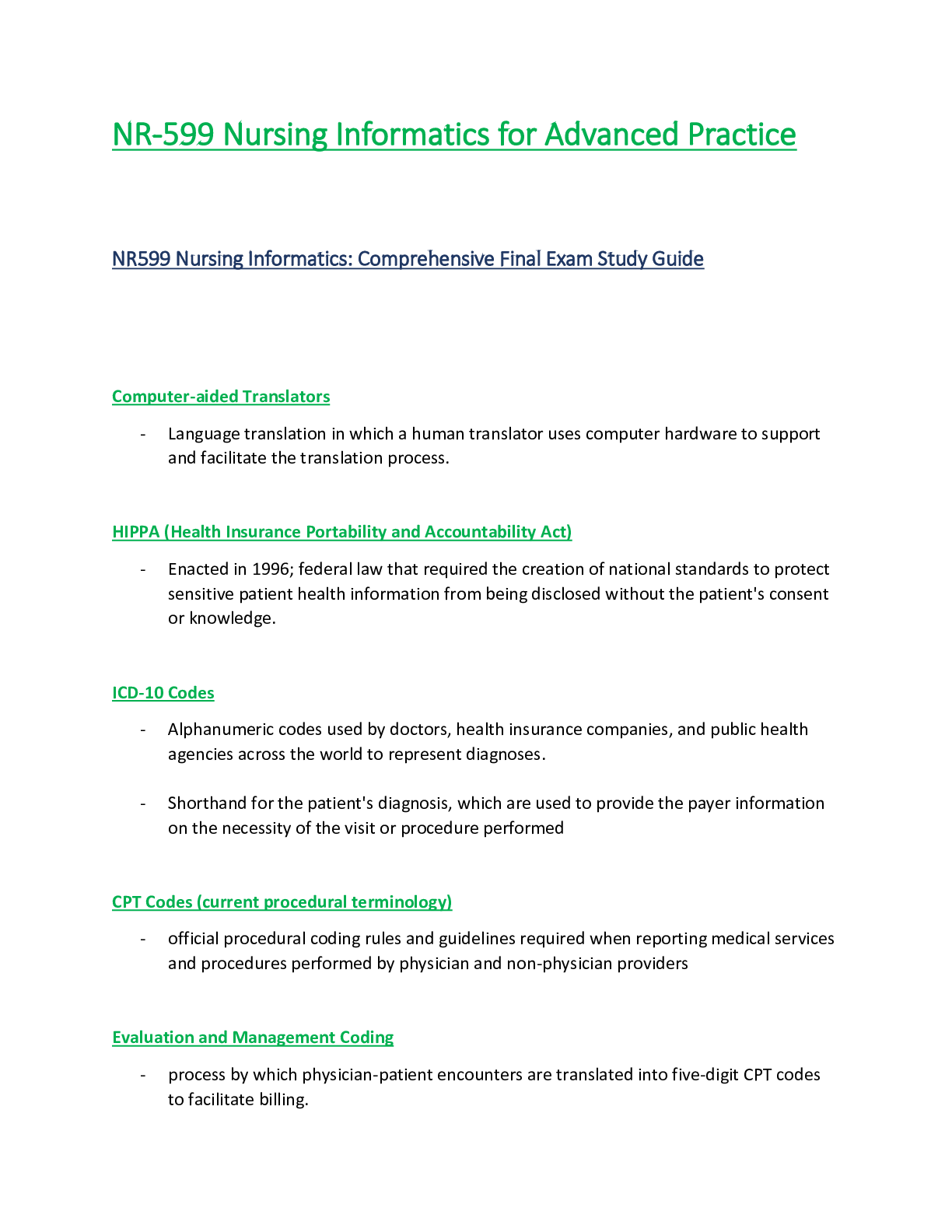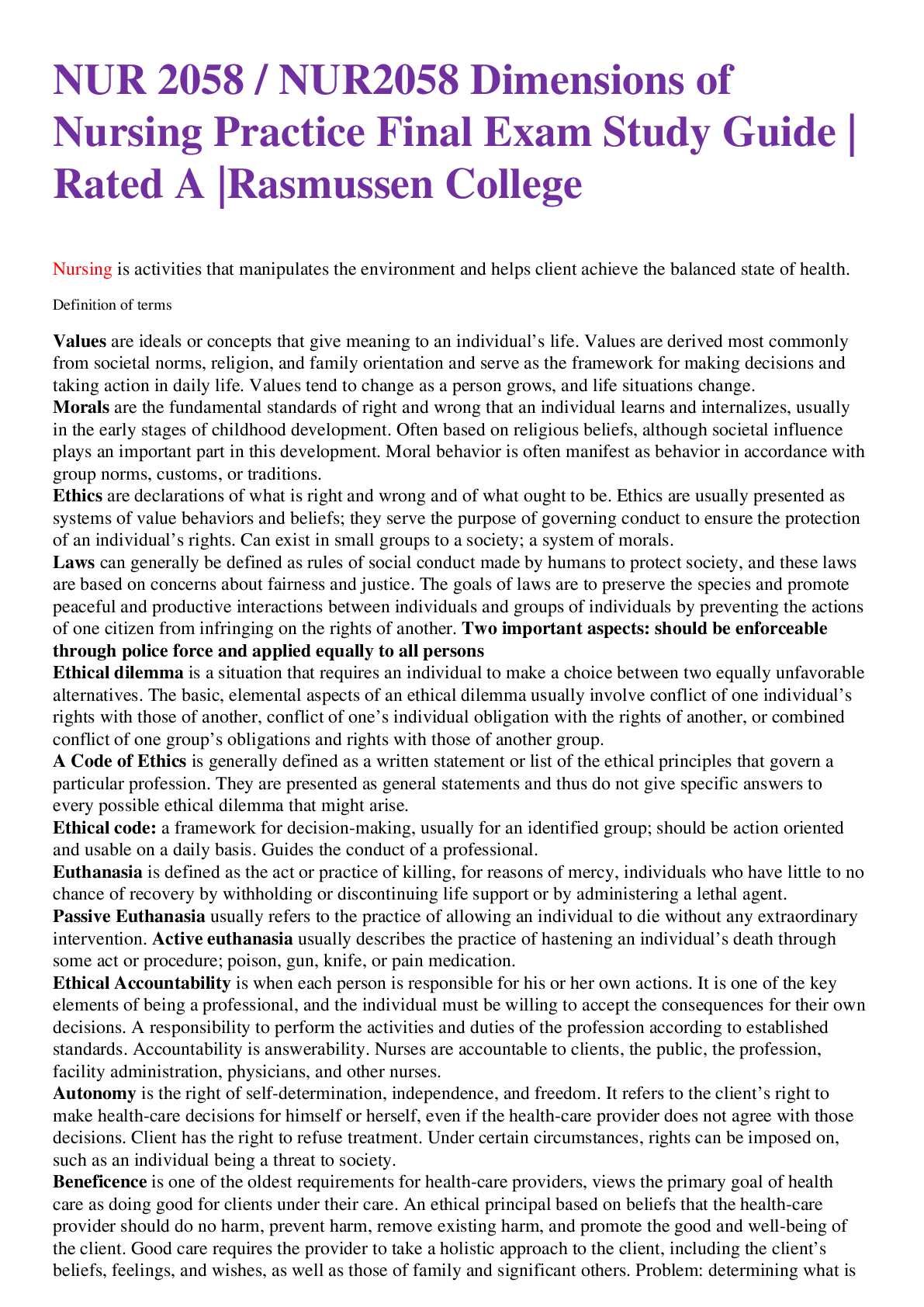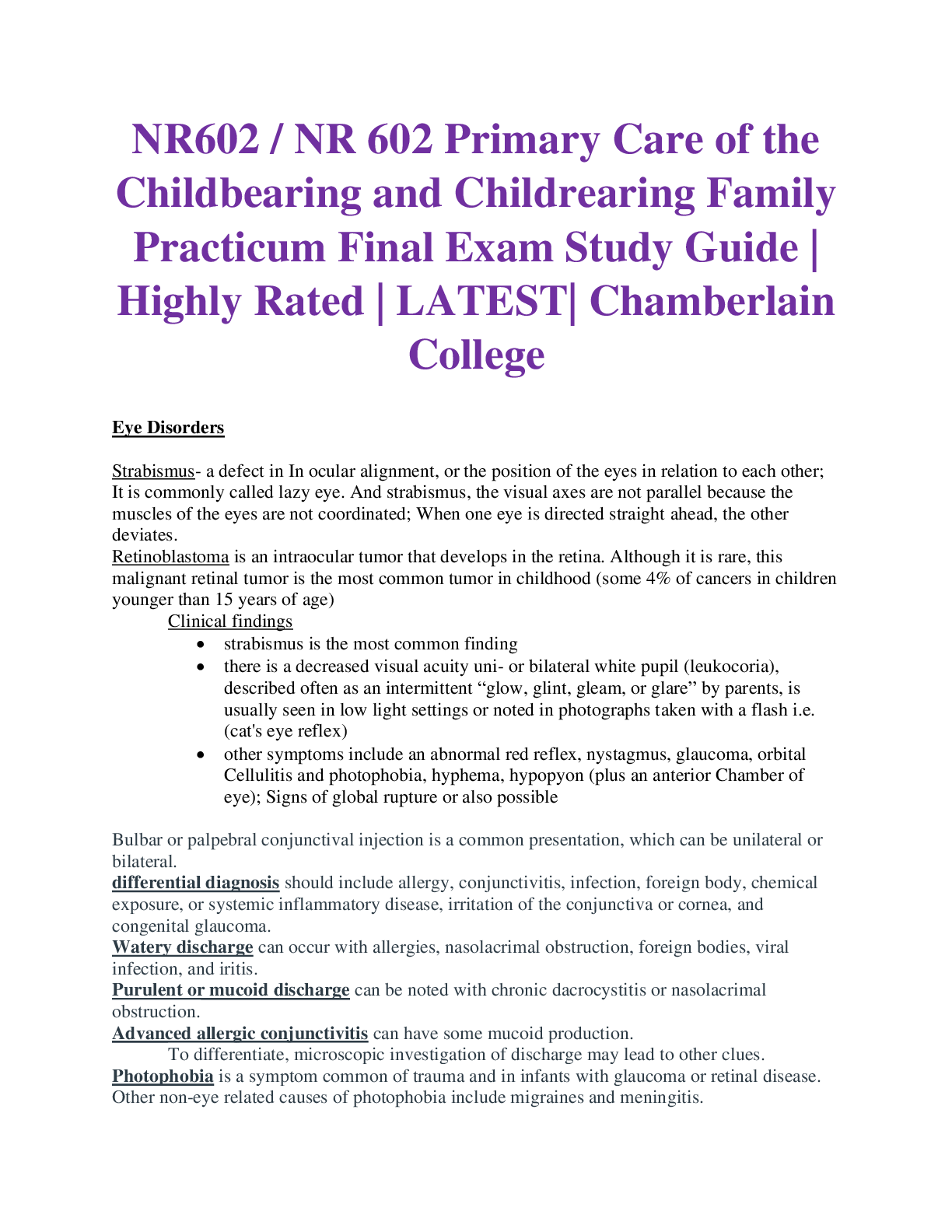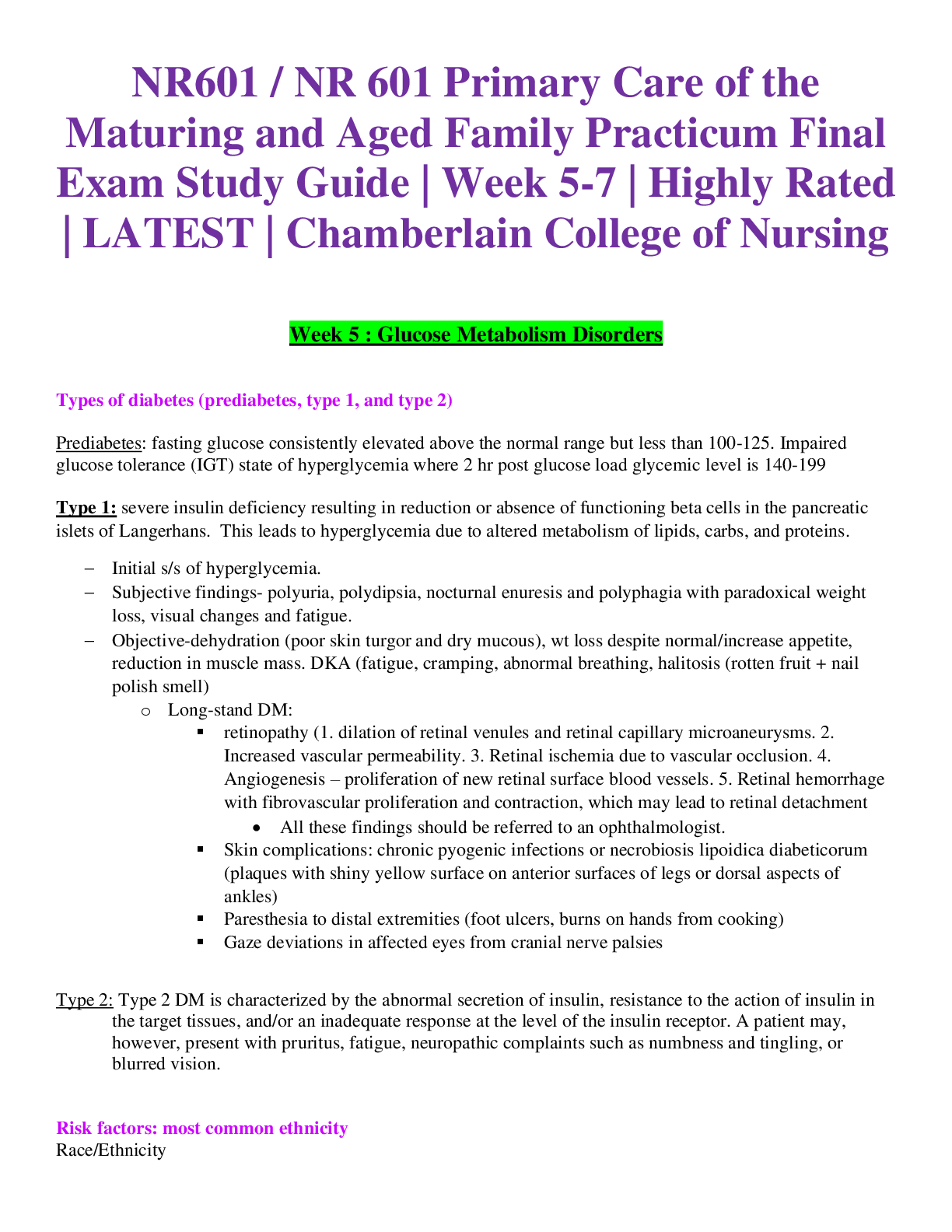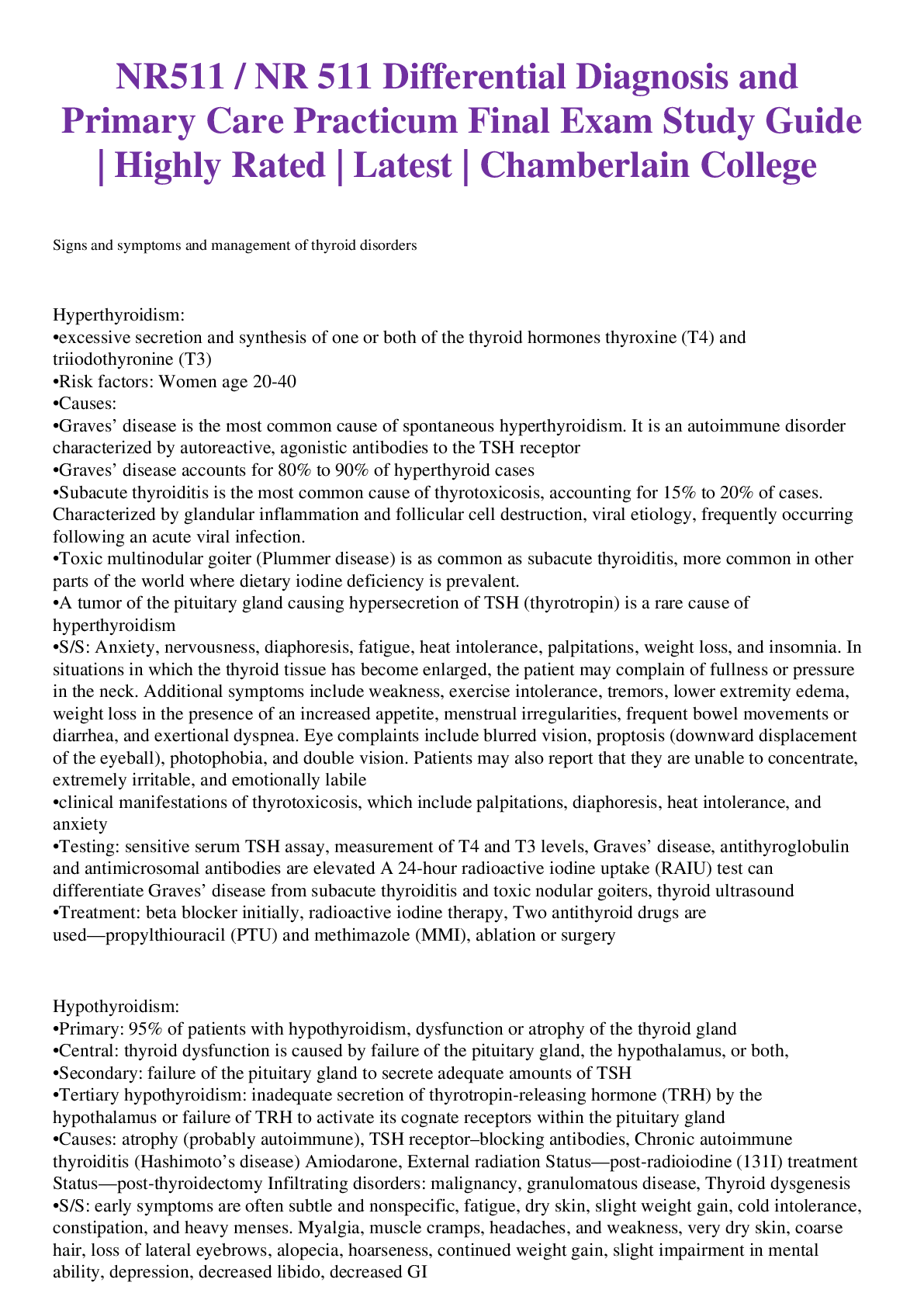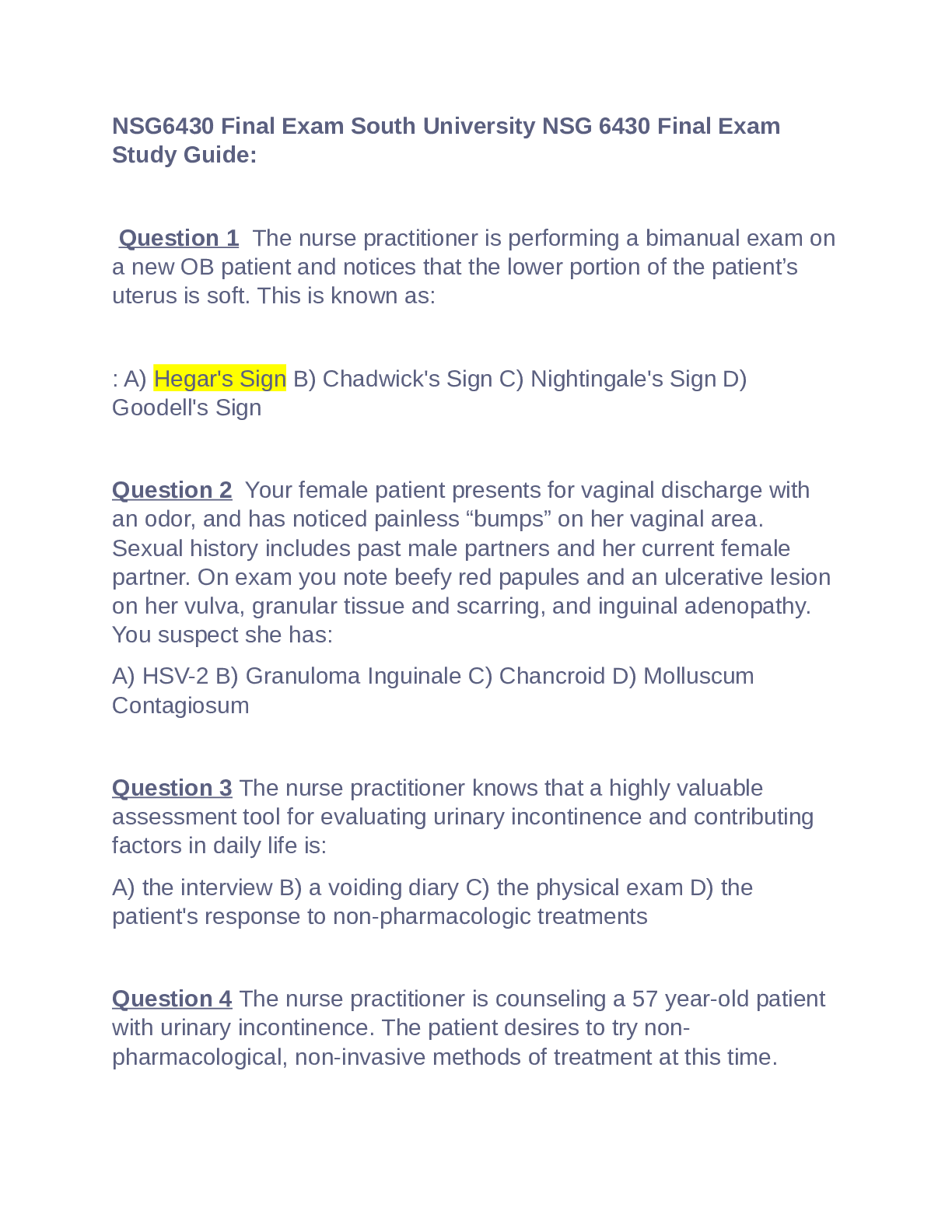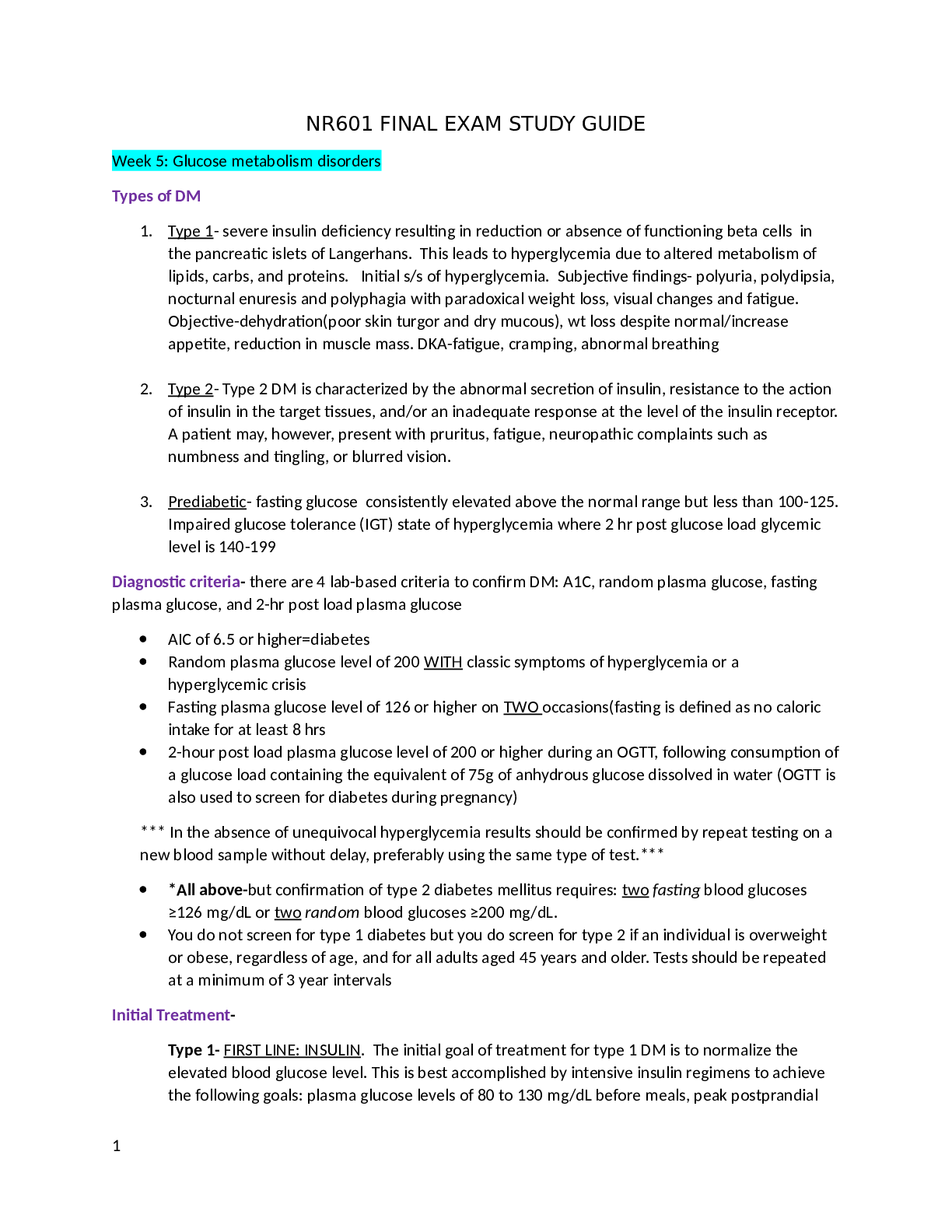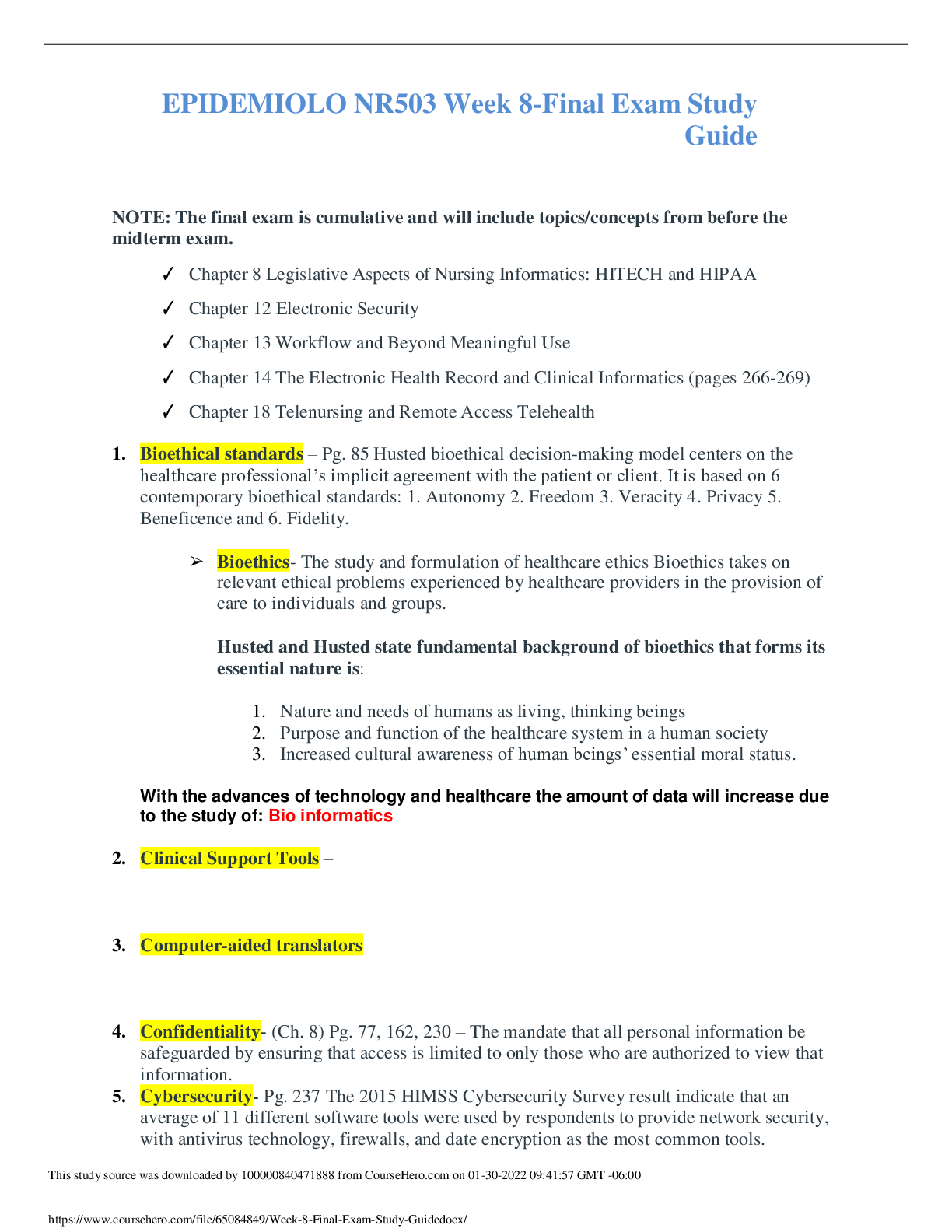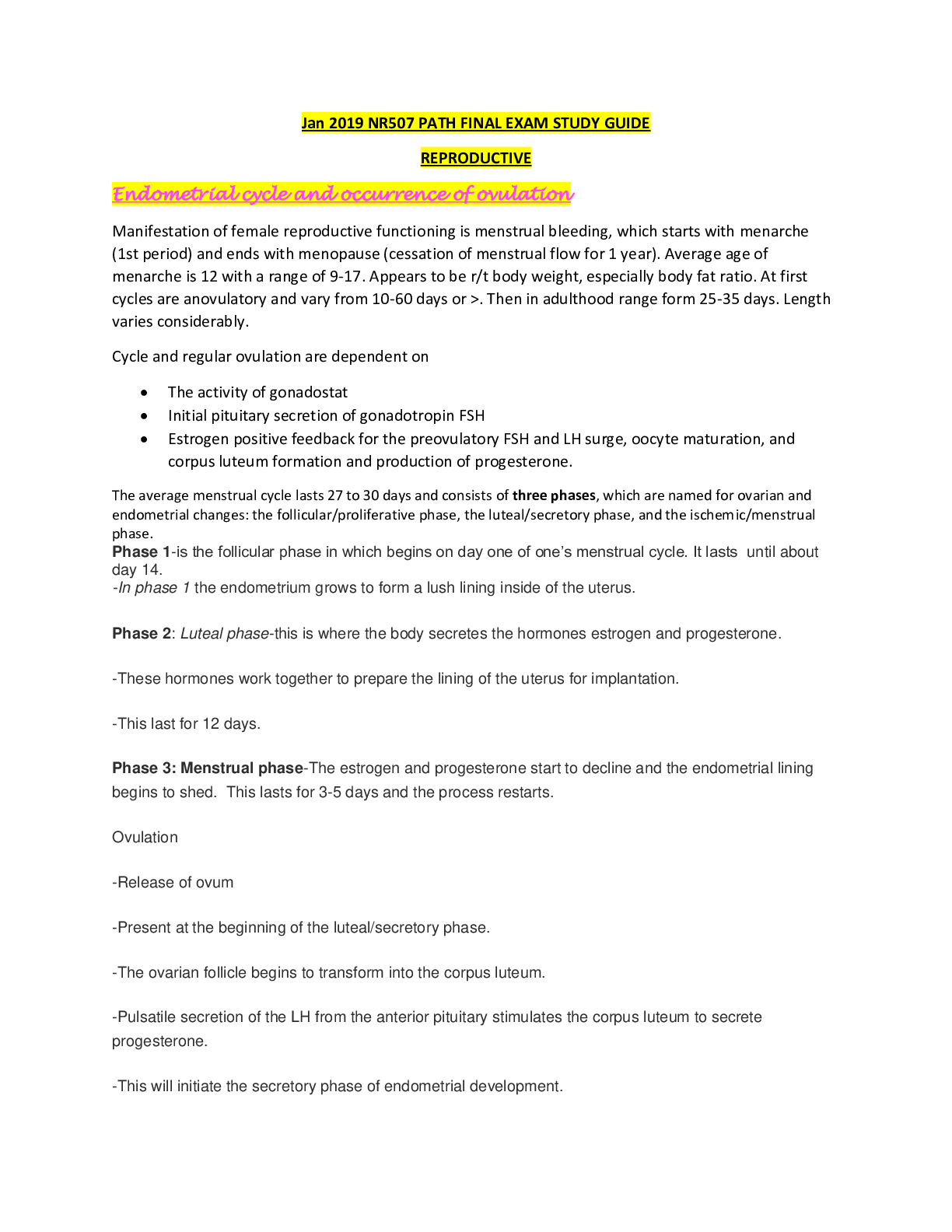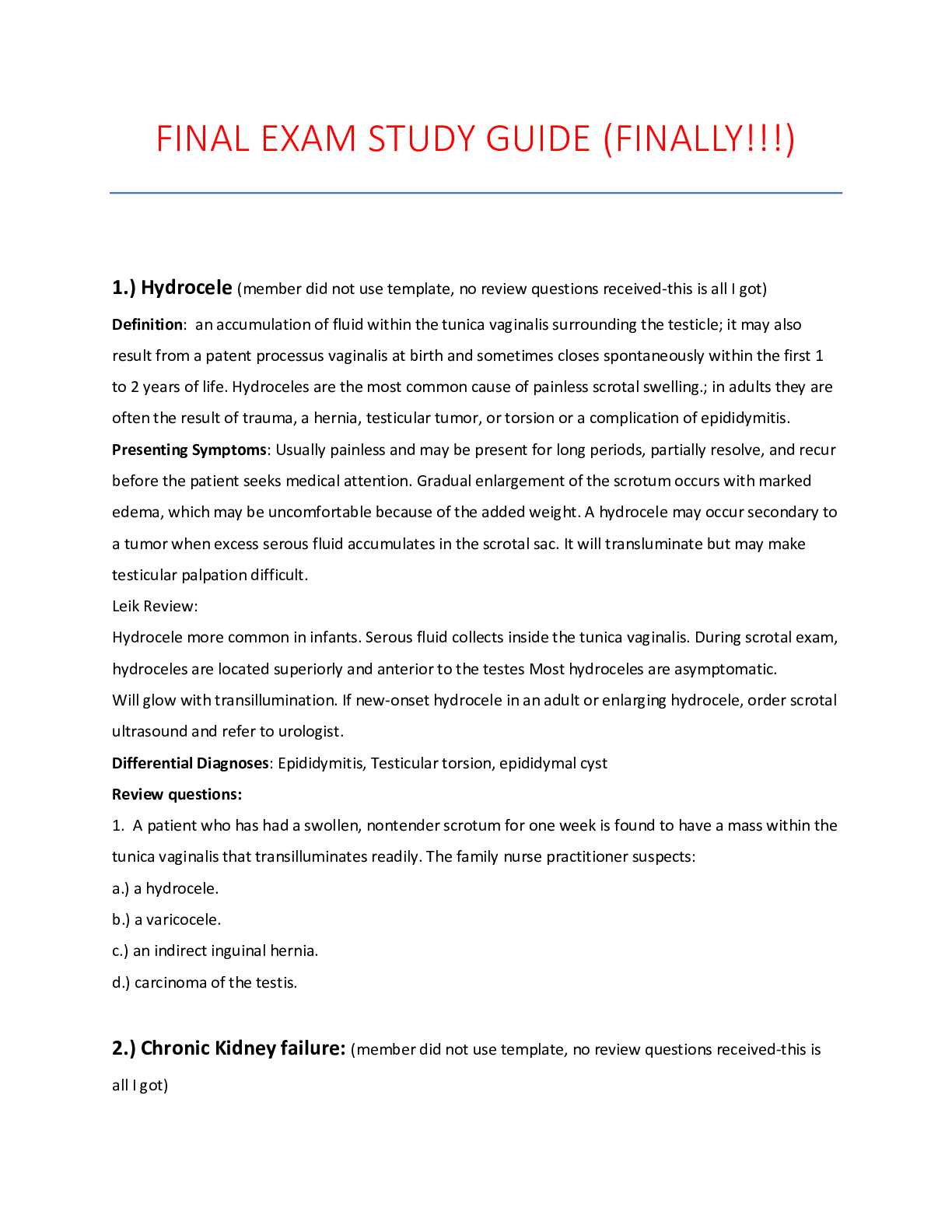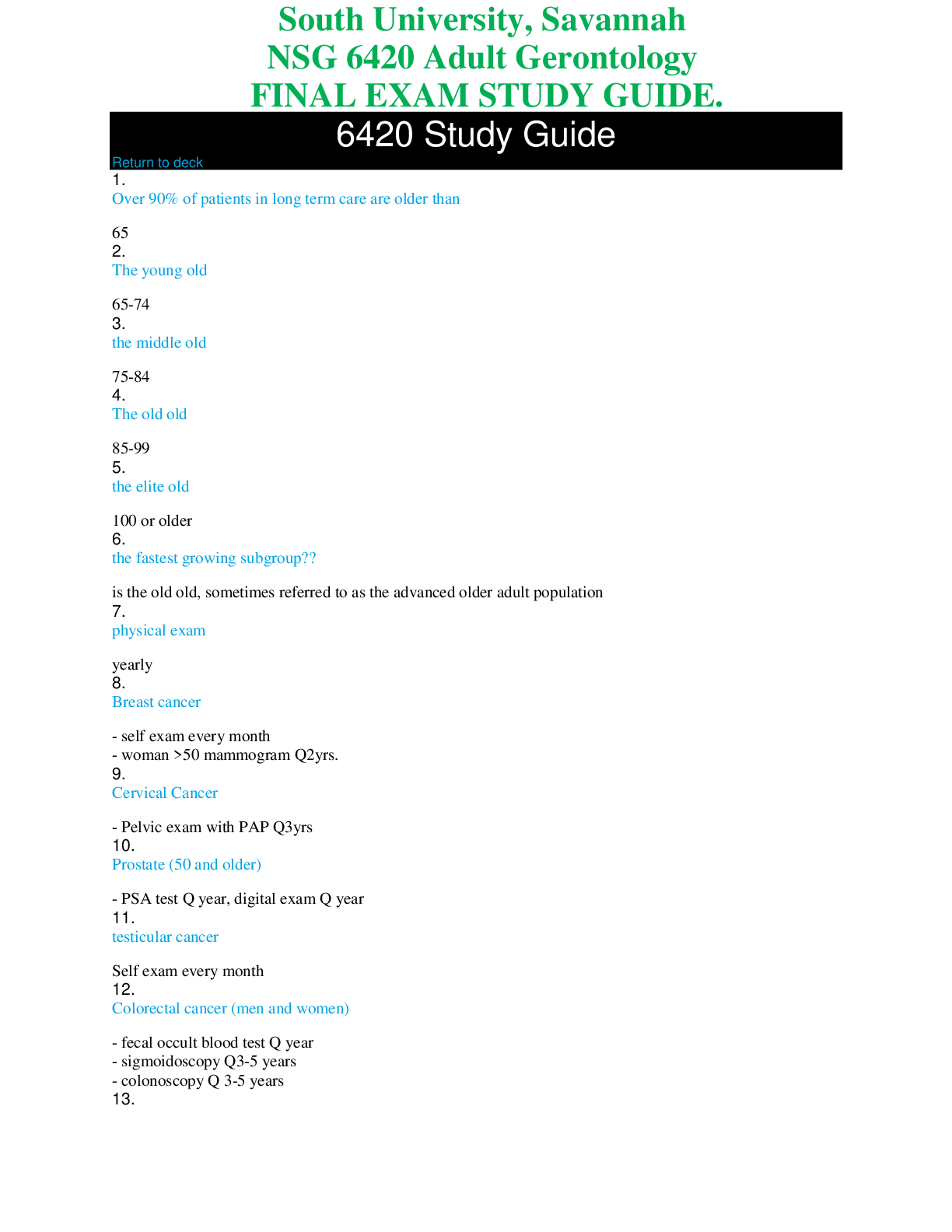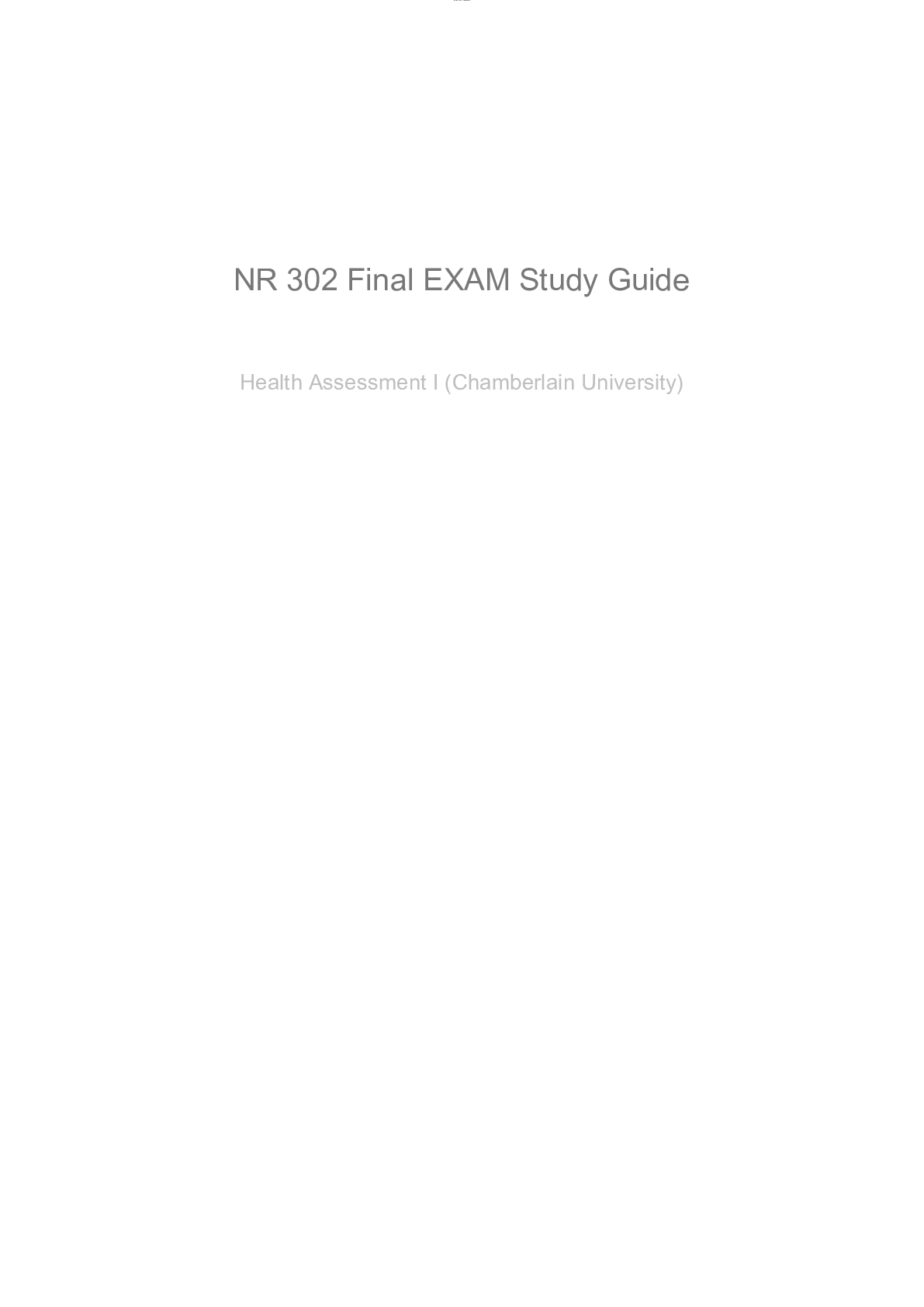*NURSING > STUDY GUIDE > NR 509 Final Exam Study Guide (ALL YOU NEED!) (All)
NR 509 Final Exam Study Guide (ALL YOU NEED!)
Document Content and Description Below
NR 509 Final Exam Study Guide. Sign up for an individual topic or chapter, whichever you prefer. Please have section completed by October 5th :) Chapter 5 Ashley (1-6)/ Catlin (7-9) Behavior/Mental H... ealth Assessment and Modification for Age -Unexplained conditions lasting >6weeks should prompt screening for depression, anxiety, or both -PRIME-MD (Primary Care Evaluation of Mental Disorders). 26 questions and take 10 minutes to complete. Used for the 5 most common=anxiety, depression, alcohol, somatoform, and eating disorders. -Patient indications for Mental Health Screening: 1.Medically unexplained physical symptoms-more than half have depression and anxiety disorders 2. Multiple physical or somatic symptoms or high symptom count 3.High severity of the presenting somatic symptoms, chronic pain 4.Symptoms for more than 6 weeks 5. Physician rating as a “difficult encounter” 6. Recent stress 7.Low-self rating of overall health 8.Frequent use of health care services 9.Substance abuse. -CAGE=substance-related and addictive disorders Modification for Age Elderly: -Complain of memory problems but usually is due to benign forgetfulness -Retrieve and process data more slowly and take longer to learn new information -Slower motor responses and their ability to perform complex task may diminish -Important to distinguish age-related changes from manifestations of mental disorders -More susceptible to delirium which can be the first sign of infection, problems with medications, or impending dementia Infant: Assess mental status of a newborn=observing newborn activities 1.Look at human faces and turn to parents voice 2.Ability to shout out repetitive stimuli 3. Bond with caregiver 4.Self-soothe Normal VS. Abnormal Findings and Interpretation -Mood disorders: compulsions, obsessions, phobias, and anxieties -Lethargic: drowsy, but open their eyes and look at you, respond to questions, and then fall asleep. -Obtunded: open their eyes and look at you, but respond slowly and are somewhat confused. -Agitated depression: crying, pacing, and hand-wringing -Depression: the hopeless slumped posture and slowed movements. -Grooming and personal hygiene may deteriorate: Depression, schizophrenia, and dementia -Manic Episode: the agitated and expansive movement of a manic episode-Obsessive-Compulsive Disorder: Excessive fastidiousness -Lesion parietal cortex: one side neglect in the opposite parietal cortex, usually in the nondominant side -Parkinsonism: facial immobility -Paranoia: anger, hostility, suspiciousness, or evasiveness -Mania: Elation and euphoria -Schizophrenia: flat affect and remoteness -Apathy (dull affect with detachment and indifference): dementia, anxiety, and depression -Hallucination: schizophrenia, alcohol withdrawal, and systemic toxicity -Amnestic Disorders: impaired memory or new learning ability and reduce social or occupational functioning, but lack the global features of delirium and or dementia. Anxiety and depression, and intellectual disability may also cause recent memory impairment. -Calculating ability: poor performance = dementia or aphasia -Variations and abnormalities in thought processes: 1.Circumstantiality: The mildest thought disorder, consisting of speech with unnecessary detail, indirections, and delay in reaching the point. Some topics may have a meaningful connection -Occurs in people with obsessions 2. Derailment: Tangential, speech with shifting from topics that are loosely connected or unrelated. The patient is unaware of the lack of association -Schizophrenia, manic episodes, and other psychotic disorders 3.Flight of ideas, an almost continuous flow of accelerated speech with abrupt changes from one topic to the next. Changes are based on understandable associations, play on words, or distracting stimuli, but ideas are not well connected. -Manic episodes 4.Neologisms: invented or distorted words, or words with new and highly idiosyncratic meanings -Schizophrenia, psychotic disorders, and aphasia 5.Incoherence: Speech that is incomprehensible and illogical, with lack of meaningful connections, abrupt changes in topic, or disordered grammar or word use. Flight of ideas, when severe, may produce incoherence -Schizophrenia 6.Blocking: Sudden interruption of speech in mid sentence or before the idea is completed “losing the thought” -Schizophrenia 7.Confabulation: Fabrication of facts or events, to fill in the gaps from impaired memory -Korsakoff syndrome from alcoholism 8.Perseveration: persistent repetition of words or ideas -Schizophrenia or other psychotic disorders 9. Echolalia: Repetition of the words and phrases of others -Manic episodes or Schizo 10.Clanging: Speech with choice of words based on sound, rather than meaning, as in rhyming and punning. Example: “look at my eyes and nose, wise eyes and rosy nose. To to one, the ayes have it!” -Schizo and manic episodes Abnormalities of Perception 1. Illusions: misinterpretations of real external stimuli, such as mistaking rustling leaves for the sounds of voices -Grief, delirium, PTSD, Schizo2.Hallucinations: Perception-like experiences that seem real but, unlike illusions, lack actual external stimulation. The person may or may not recognize the experiences as false. May be auditory, visual, olfactory, gustatory, tactile, or somatic. -PTSD, Schizo, delirium, dementia, alcoholism Abnormalities of Thought Content 1.Compulsions -repetitive behaviors feel driven to perform in response to an obsession (anxiety disorders) 2.Obessions -Recurrent persistent thoughts, images, or urges 3.Phobias -Persistent irrational thoughts, compelling desire to avoid provoking stimulus 4.Anxieties 5.Feelings of unreality 6.Feelings of Depersonalization 7.Delusions Erotomanic: the belief that another person is in love with the individual Somatic: involves body functions Unspecified: includes delusions of reference without a prominent persecutory or grandiose component Speech Patterns -Slow speech: depression -Accelerated speech: mania -Articulation: are the words clear and distinct: does the speech have a nasal quality -Dysarthria: defective articulation “slurred speech” -Dysphonia: results from impaired volume, quality, or pitch of voice. Difficulty speaking due to a physical disorder of the mouth, tongue, throat, or vocal cords. -Aphasia: the loss of ability to understand (receptive/Wernicke) or express speech (expressive/Broco aphasia) -Brocas aphasia: patients articulate very slowly and with a great deal of effort. Nouns, verbs, important adjectives are usually present and only small grammatical words are dropped from speech "Well…..cat and…..up……..um, well, um…forget it" -Wernicke's aphasia the patient can speak effortlessly and fluently, but his words often make no sense “the coffee cat looks crazy still” -Cerebrovascular infarction -Fluency: fluency reflects the rate, flow, and melody of speech and the content and use of words. Abnormalities -Hesitancies and gaps in the flow and rhythm of words -Disturbed inflections, such as monotone -Circumlocutions: phrases or sentences are substituted for a word the person cannot think of. Example “what you write with for “pen” -Paraphasia: malformed, wrong, or invented -Testing for Aphasia -Word comprehension: ask the patient to follow one-stage commands such as “Point to your nose” -Repetition -Naming -Reading comprehension-Writing Mental Status Examination Brief test used to screen for cognitive dysfunction or dementia, and follow the patients course over time. 1. Orientation 2.Short-term memory-retention/recall 3.Language 4.Attention 5.Calculation 6.Constructive Praxis Example of findings that suggest dementia: “The patient appears sad and fatigued; clothes are wrinkled. Speech is slow and words are mumbled. Thought processes are coherent, but insight into current life reverses is limited. The patient is oriented to person, place, and time. Digit span, serial 7s, and calculations accurate, but responses delayed. Clock drawing is good. Screening for Depression High Yield Screening Questions for office practice: 1. over the past 2 weeks, have you felt down, depressed, or hopeless? 2. Over the past 2 weeks, have you felt little interest or pleasure in doing things (anhedonia)? Symptoms of depression: low self-esteem, loss of pleasure (anhedonia), sleep disorder, difficulty concentrating. Depression tends to be long-lasting and can recur. Suicide is the second leading cause of death among 15-24 year old. Suicide rate are the highest among those ages 45 to 54, followed by elderly adults 85 years old or older. 90 % of suicide is non-hispanic whites. Other symptoms of depression: headaches, muscle aches, fatigue Generalized Anxiety Disorder -Most common mental disorder in primary care - High Yield Screening Questions for office practice: 1. Over the past 2 weeks, have you been feeling nervous, anxious, on edge, unable to stop or control worrying? 2. Over the past 4 weeks, have you had an anxiety attack-suddenly feeling fear or panic? You can screen for core anxiety symptoms by asking the first two questions from the 7- item generalized anxiety disorder (GAD) scale. Scores on this GAD subscale range from 0 to 6; a score of 0 suggests that no anxiety disorder is present. A score of 10 on the GAD-7 identifies GAD; scores of 5, 10, and 15 represent mild, moderate, and severe levels of anxiety. Depressive Disorders Depression and anxiety disorders are a common cause of hospitalization in the United States, and mental illness is associated with increased risks for chronic medical conditions, decreased life expectancy, disability, substance abuse, and suicide. About 19million adult American or almost 7% have major depression with other co- existing anxiety disorder or substance abuse. Depression is as common in women asmen, and the prevalence of postpartum depression is about 7% to 13%. Most patients with chronic medical conditions have depression. Symptoms of depression in high-risk patients may be subtle and may include; 1. Low self-esteem 2. Loss of pleasure in daily activities (Anhedonia) 3. Sleep disorder, 4. Difficulty concentrating or making decisions. Look carefully for symptoms of depression in vulnerable patients, especially those who are young, female, single, divorced or separated, seriously or chronically ill, bereaved, or have other psychiatric disorders, including substance abuse. A personal or family history of depression also places patients at risk. Asking two simple questions about mood and anhedonia appears to be as effective as using more detailed instruments. All positive screening tests warrant full diagnostic interviews. Failure to diagnose depression can have fatal consequences—the presence of an affective disorder is associated with an 11-fold increased risk for suicide. Depression screening 1. Over the past 2 weeks, have you felt down, depressed, or hopeless? 2. Over the past 2 weeks, have you felt little interest or pleasure in doing things (anhedonia)? Depression tends to be long-lasting and can recur. Because of these two factors, a wait- and-see approach to treatment is not desirable and timely treatment is necessary. Schizophrenia 1. Grooming and personal hygiene may deteriorate 2. flat affect and remoteness 3. Hallucinations: lack actual external stimulation 4. Derailment: Tangential, speech with shifting from topics that are loosely connected or unrelated. The patient is unaware of the lack of association. 5. Neologisms: invented or distorted words, or words with new and highly idiosyncratic meaning 6. Incoherence: Speech that is incomprehensible and illogical, with lack of meaningful connections, abrupt changes in topic, or disordered grammar or word use. 7. Flight of ideas, when severe, may produce incoherence 8. Blocking: Sudden interruption of speech in mid sentence or before the idea is completed “losing the thought” 9. Clanging :speech with choice of words based on sound, not meaning 10. Echolalia: repetition of the words and phrases 11. Illusions: mistinterpretations of real external stimuli (mistaking rustling leaves for the sound of voices) 12. Usually occurs in late teens, early 20s (college students, common psych break) 13. Commonly seen in other family members Suicide Risk and Prevention Protective factors buffer individuals from suicidal thoughts and behavior. To date, protective factors have not been studied as extensively or rigorously as risk factors.Identifying and understanding protective factors are, however, equally as important as researching risk factors. Protective Factors ● Effective clinical care for mental, physical, and substance abuse disorders ● Easy access to a variety of clinical interventions and support for help seeking ● Family and community support (connectedness) ● Support from ongoing medical and mental health care relationships ● Skills in problem solving, conflict resolution, and nonviolent ways of handling disputes Cultural and religious beliefs that discourage suicide and support instincts for self- preservation Suicide is the second leading cause of death among 15- to 24-year olds. Suicide rates are highest among those ages 45 to 54 years, followed by elderly adults ≥age 85 years. Men have suicide rates nearly four times higher than women, though women are three times more likely to attempt suicide. Men are most likely to use firearms to commit suicide, while women are most likely to use poison. Overall, suicides in non-Hispanic whites account for about 90% of all suicides. American Indian/Alaska Native women ages 15 to 24 years have the highest suicide rates of any racial/ethnic group. Substance Use Disorders, Including Alcohol and Prescription Drugs. The harmful interactions between mental disorders and substance use disorders also present a major public health problem. Rates of drug-induced deaths continue to increase and are highest among whites and American Indian/Alaska Natives. The Centers for Disease Control and Prevention reports that prescription drugs have replaced illicit drugs as a leading cause of drug-induced deaths. Every patient should be asked about alcohol use, substance abuse, and misuse of prescription drugs Suicide Risk and Prevention Risk Factors ● Family history of suicide ● Family history of child maltreatment ● Previous suicide attempt(s) ● History of mental disorders, particularly clinical depression ● History of alcohol and substance abuse ● Feelings of hopelessness ● Impulsive or aggressive tendencies ● Cultural and religious beliefs (e.g., belief that suicide is noble resolution of a personal dilemma) ● Local epidemics of suicide ● Isolation, a feeling of being cut off from other people ● Barriers to accessing mental health treatment ● Loss (relational, social, work, or financial) ● Physical illness ● Easy access to lethal methods ● Unwillingness to seek help because of the stigma attached to mental health and substance abuse disorders or to suicidal thoughts Chapter 9 & 12 Kailey/JennaCardiac/Vascular Assessment and Modification for Age Normal VS. Abnormal Findings and Interpretation -Acute aortic dissection: anterior chest pain, often tearing or ripping and radiating into the back or neck. -Sudden dyspnea: PE, PNEUMO, and anxiety -PMI (point of maximal impulse) APEX OF THE LEFT VENTRICLE identified during palpation of the precordium, locates the left border of the heart and is normally found in the 5th intercostal space at or just medial to the left midclavicular line (or 7 to 9 cm lateral to the midsternal line). Normal diameter 1 to 2.5 cm. The left ventricle, behind the RV and to the left, forms the left margin of the heart, its tapered inferior tip is often termed the cardiac apex which produces the apical impulse, identified during palpation of the precordium as the PMI. Abnormal PMI 1. Situs inversus and dextrocardia->PMI located at the right side of chest 2. PMI>2.5cm-> left ventricular hypertrophy from HTN or aortic stenosis causing pressure overload in the left ventricle 3. Displacement of the PMI lateral to the midclavicular line or > 10 cm lateral to the midsternal line-> LVH and Ventricular dilatation from a MI or heart failure 4. COPD patients-> the PMI may be in the xiphoid or epigastric area due to right ventricular hypertrophy 5. Hyperkinetic high-amplitude=hyperthyroidism severe anemia, HTN, aortic stenosis, and aortic regurgitation 6. Sustained high amplitude- increased LVH from HTN Cardiac chambers, valves, and circulation 1. AV valves= Mitral and Tricuspid (based on location) 2. Semilunar valves= Aortic and Pulmonic (based on half-moon shape) 3. S1 & S2=vibrations emanating from the leaflets, the adjacent cardiac structures, and the flow of blood. 4. S1=Closure of the mitral valve 5. s2=Aortic valve closure 6. S2 split= Closure of aortic valve and then pulmonic valves, best heard over the pulmonic area with the bell of the stethoscope 7. S3 & S4= Heart failure or acute myocardial ischemia 8. S3=caused by rapid deceleration of blood against the ventricular wall 9. S4= increased left ventricular end diastolic stiffness which decreases compliance 10. Systolic blood pressure=maximal left ventricular pressure 11. Diastole= left ventricular pressure continues to drop and falls below left atrial pressure. The mitral valve opens, event usually silent but may be audible if valve leaflet motion to restricted (mitral stenosis) 12. Right ventricle is the chamber that you can assess by palpation since it occupies most of the anterior surface of the heart. Events in the Cardiac Cycle1. Systole= Ventricular contraction 5mm HG to 120 mm HG. Blood ejected into Aorta. Aorta valve open and mitral closed. 2. Diastole= Ventricular relaxation blood flows from atrium to ventricular. Aorta valve closed, and mitral valve open. Normal JVP: 3 cm above the sternal angle, in patients with obstructive lung disease, JVP can appear elevated on expiration but veins collapse on inspiration. 1. Jugular venous pressure-reflect right atrial pressure which in turn equals central venous pressure and right ventricular end-diastolic pressure.Lies deep in SCM muscles. Abnormal JVP: falls with loss of blood or decreased venous vascular tone and increases with right or left heart failure, HTN, tricuspid stenosis, AV dissociation, increased vascular tone, and pericardial compression or tamponade. Jugular Venous Pulsations 1. A-atrial contraction, C-carotid transmission, V-venous filling 2. Abnormally prominent waves occur: increased resistance to right atrial contraction, tricuspid stenosis, 1st/2nd/3rd degree AVB, SVT, junctional tachycardia, pulmonary HTN, pulmonic stenosis. 3. Absent a waves=A FIB 4. Systolic phenomenon is the X descent 5. Increased V waves=occur in tricuspid regurgitation, atrial defects, and constrictive pericarditis. 6. Abnormal: >3 cm above sternal angle (NOT NOTCH) or > 8 cm above right atrium, best measured at the end of expiration 7. The vertical height of the blood column in centimeters, plus 5 cm, is the JVP Carotids Characteristics: amplitude, contour, timing of upstroke in relation to S1 and S2 Normal: 2+, no bruits or thrills Abnormal: small, thready or weak in cardiogenic shock, and bounding in aortic regurgitation 1. Carotid upstroke is delayed in aortic stenosis 2. Carotid pulse mall, thready, or weak= cardiogenic shock 3. The pulse pounding= aortic regurgitation 4. Bruit-murmur like sound arising from turbulent arterial blood flow. Caused by- atherosclerotic luminal stenosis 5. Carotid vs. Jugular: carotid is palpable Dextrocardia-a rare congenital transposition of the heart, the heart is situated in the right chest cavity and generates a right-sided apical impulse. Pulsus alternans: a bigeminal pulse that varies from beat to beat, almost always indicates LV dysfunctions Paradoxical pulse: varies with respiration, greater than normal drop in BP during inspiration, suspected with cardiac tamponadeCardiovascular Risk Factors Screening - Heart Disease: long asymptomatic latent period. Assess lifetime risk in asymptomatic patients starting at age 20 since many deaths occurs from lack of prior warning signs or cardiac diagnosis. -AHA guidelines recommend screening every 2 years in patients over 20 for blood pressure, body mass index, waist circumference, and pulse -The physical examination criteria for identifying metabolic syndrome include a waist of 40 inches or greater for males, a waist of 35 inches or greater for females, and a blood pressure of 130/85 or greater (in both males and females). - Women: o CVD and CHD higher in black women then white women. o Women> 65: higher prevalence of HTN than men. o Stroke 60% deaths o Unique risk factors: pregnancy, hormone therapy, early menopause, preeclampsia. More likely to have a-fib, migraine with aura, obesity, and metabolic syndrome. - Major cardiovascular risk factors and screening frequency o Family hx of CVD o Cigarette smoking o Poor diet o Physical inactivity o Obesity (especially central) o Hypertension o Dyslipidemias: screen for men >35 and women >45 with increase risk of CHD; screen by age 20 in those who have DM, HTN, obesity, tobacco use, noncoronary atherosclerosis, or family hx of early CVD. o Diabetes: Screen at age 45 and repeat every 3 years; screen at any age when BMI >25 with additional risk factors. o Pulse o Metabolic syndrome: cluster of risk factors that increase both CVD and DM. Presence of 3 of the 5 risk factors: § Waist circumference men>102cm; women >88cm § Fasting plasma glucose: >100; or being treated for high BS § HDL cholesterol: men <40 women ;<50; or being treated § Triglycerides: >150; or being treated § BP: >130/85; or being treated Heart Disease Heart Sounds (jen) Heart Sounds - Closure of the heart valves creates a pair of audible heart sounds. - The first sound, S1, arises from closure of the mitral valve. - Tricuspid valve closure may also contribute to S1. - The second sound, S2, arises from closure of the aortic valve. - Pulmonic valve closure may also contribute to S2. - Ventricular diastole occurs between S2 and the next S1. - After the mitral valve opens, there is a period of rapid ventricular filling as blood flows early in diastole from left atrium to left ventricle. - Third heart sound: S3 o In children and young adults (35-40 and last trimester of pregnancy), may arise from rapid deceleration of the column of blood against the ventricular wall. o An S3 in adults over age 40 years (an S3 gallop) is usually pathologic, arising from high left ventricular filling pressures and abrupt deceleration of inflow across the mitral valve at the end of the rapid filling phase of diastole. Causes include decreased myocardial contractility, heartfailure, and ventricular volume overload from aortic or mitral regurgitation, and left-to-right shunts. o Left-side S3; heard at apex with pt on left lateral position o Right-sided S3: heard at lower left sternal border or below xiphoid with pt supine; louder on inspiration - Fourth heart sound, S4, o not often heard in normal adults, and marks atrial contraction. o It immediately precedes S1 of the next beat and can also reflect a pathologic change in ventricular compliance. o Causes of a left-sided S4 include hypertensive heart disease, aortic stenosis, and ischemic and hypertrophic cardiomyopathy. o Left-sided S4 best heard at apex in left lateral decubitus position. o Right-sided S4 heard along lower left sternal border or below xiphoid. Louder with inspiration. - The fact that diastole usually lasts [Show More]
Last updated: 1 year ago
Preview 1 out of 75 pages

Reviews( 0 )
Document information
Connected school, study & course
About the document
Uploaded On
Sep 13, 2021
Number of pages
75
Written in
Additional information
This document has been written for:
Uploaded
Sep 13, 2021
Downloads
0
Views
41

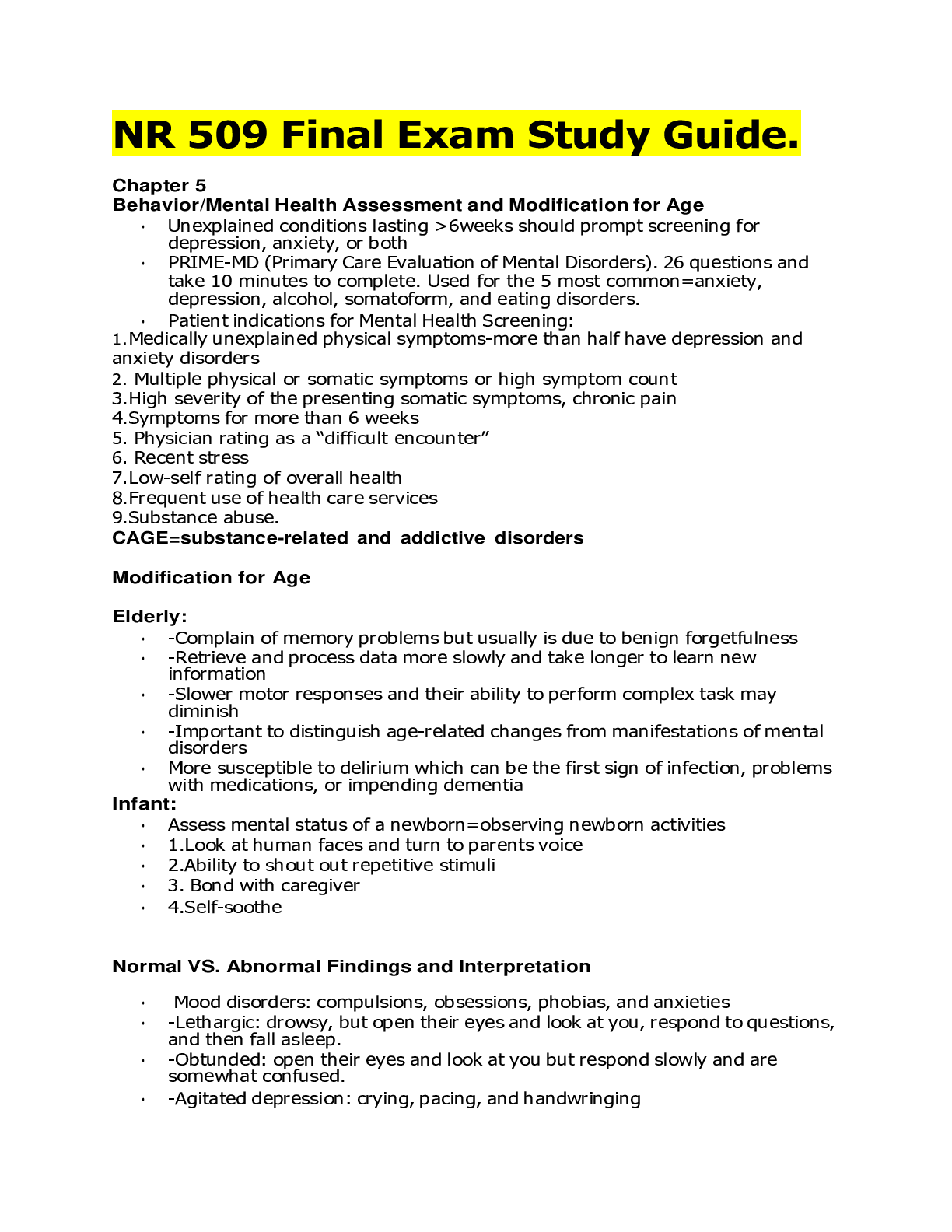
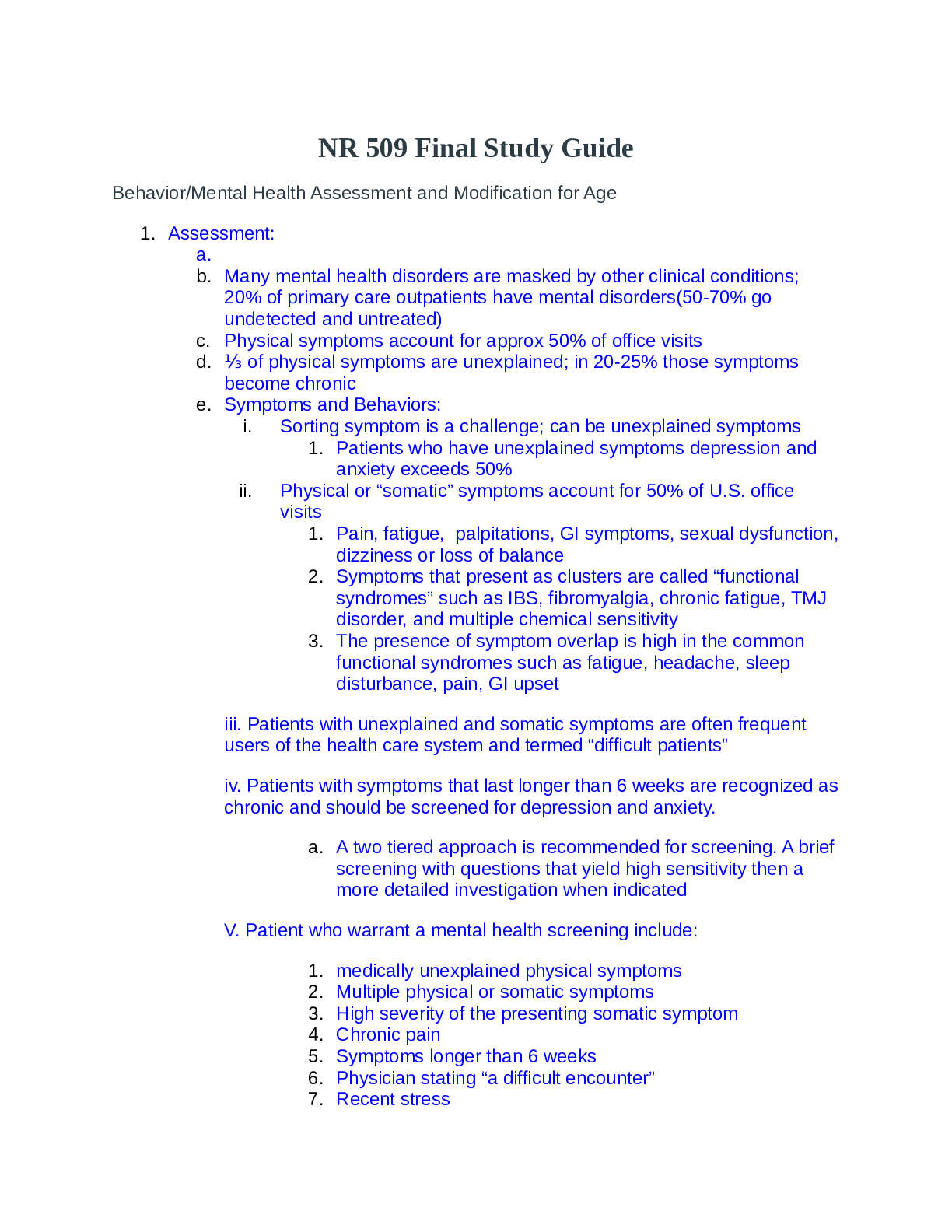



 Rasmussen College.png)
